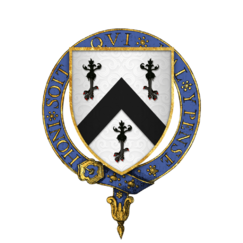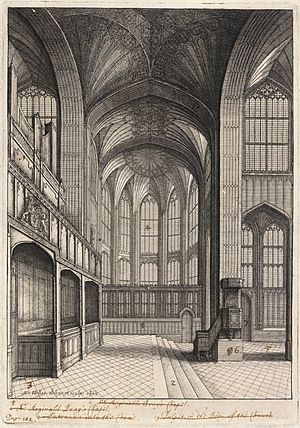Reginald Bray facts for kids
Quick facts for kids
Sir Reginald Bray
|
|
|---|---|

Arms of Sir Reginald Bray, KG: Argent, a chevron between three eagle's legs erased sable
|
|
| Chancellor of the Duchy of Lancaster | |
| In office 13 September 1486 – 5 August 1503 |
|
| Monarch | Henry VII |
| Preceded by | Thomas Metcalfe |
| Succeeded by | John Mordaunt |
| Personal details | |
| Born | c. 1440 St. John Bedwardine, Worcestershire |
| Died | 5 August 1503 City of London |
| Nationality | English |
| Spouse | Katherine Hussey |
Sir Reginald Bray (born around 1440 – died 5 August 1503) was an important English administrator and statesman. He worked for King Henry VII as the Chancellor of the Duchy of Lancaster. He was also briefly the Treasurer of the Exchequer. Sir Reginald was one of the most powerful people in Henry VII's government.
He was a key advisor to both King Henry VII and the king's mother, Margaret Beaufort. He also gave a lot of money to St George's Chapel, Windsor. You can still see parts of the building he helped pay for today.
Contents
Early Life and Work Before 1485

Reginald Bray was born around 1440 in a place called St. John Bedwardine, near Worcester. He was the second son of Richard Bray, who was a surgeon.
Reginald and his younger brother, John, started working for Margaret Beaufort. She was the mother of Henry Tudor, who would later become King Henry VII. By 1465, Reginald was managing her money and estates.
Margaret often sent Bray on important tasks to her son, Henry. For example, in 1469, he brought young Henry Tudor money from his mother. This money was so Henry could buy a bow and arrows.
Bray continued to work for Margaret Beaufort for over twenty years. He served her and her husbands, Henry Stafford and Thomas, Lord Stanley.
He played a big part in secret plans between 1483 and 1485. These plans aimed to help Henry Tudor become the King of England. Bray remained Margaret Beaufort's chief financial manager until he died in 1503.
Sir Reginald Bray's Career (1485-1503)
After Henry Tudor became King Henry VII, Bray quickly became very important in the new government. He had the king's full trust and was very close to him. On September 13, 1485, Bray was made Chancellor of the Duchy of Lancaster. He held this job for the rest of his life.
This role gave him great power, many responsibilities, and a lot of respect. It also brought him wealth. Bray was one of only seven men made a Knight of the Bath when Henry VII was crowned king.
Raising Money for the King
In late 1485, Bray was busy doing what he did best: finding money for the king. He worked with a merchant named Avery Cornburgh to manage the king's money. On February 28, 1486, he became the Lord High Treasurer, a very important financial role. He held this position until July 1486.
He continued to have financial duties until his death in 1503. He was also the Treasurer of War when the king planned to invade France in 1492. When peace was made with France, Bray personally received money from the King of France.
Other Important Roles
In 1494, Bray was chosen as the Steward of the University of Oxford. This job included legal responsibilities. After the Battle of Blackheath in 1497, he was honored as a knight banneret. In 1501, he became a Knight of the Garter, which is a very high honor.
He also served as a Member of Parliament (M.P.) for Newcastle-under-Lyme in 1478. He was M.P. for Hampshire in 1491, 1495, and 1497.
Bray's Influence and Building Projects
Bray's influence came from more than just his official jobs. He was one of the king's most important advisors. Around 1499, he helped lead a special group called the Council Learned. This group met to deal with legal and financial matters for the king.
Bray was known as a source of help and a way to get the king's attention. People would give him gifts or offer him jobs to gain his favor.
Bray was also a great builder. He built homes for himself, like at Edgcote and Eaton (now called Eaton Bray). He also helped fund many other projects. He contributed to Great Malvern Priory and Jesus College in Cambridge. He helped Bishop Oliver King with building work at Bath Abbey.
In January 1503, he helped lay the first stone for the king's new chapel in Westminster Abbey. However, the biggest project he supported was St George's Chapel, Windsor. He gave money during his life and left more money for it in his will.
Family Life
Around 1475, Bray married Katherine Hussey (who died in 1506). She was one of two daughters of Nicholas Hussey of Calais. They did not have any children. Katherine brought him land in Harting, Sussex, and claims to land in Berkshire and Hampshire. Most of Bray's large land holdings, however, were gained after 1485 because of his important position.
Sir Reginald Bray died on August 5, 1503. He was buried in St George's Chapel, Windsor. He had a full brother named John Bray and an older half-brother, also named John Bray. After some legal discussions, Reginald Bray's lands were divided. They went to his nephew, Edmund Bray, and to William Sandys, 1st Baron Sandys.
Remembering Sir Reginald Bray
There is no tomb for Bray today, but a coffin believed to be his was found in 1740. His important financial help for the building of St George's Chapel is still visible. You can see his coat of arms or his initials carved into stone and other materials.
You can also find his rebus (a picture puzzle representing his name) of a hemp-bray. A hemp-bray was a tool used to separate fibers from hemp plants. This was a clever way to show his name. There are 175 examples of this symbol in the Chapel. Ten more wooden carvings of the hemp-bray have been added to new furniture in the Bray Chapel.
In recent times, Bray has been remembered for his generosity. A 'Bray Fellowship' was created to raise money for major repairs at the Chapel. HRH Prince Philip was an honorary senior fellow. A Canadian Bray fellowship was also started. In 2017, the Royal Mail released special postage stamps celebrating Windsor Castle and St George's Chapel. One stamp showed a stone carving with Bray's initials.
Images for kids


